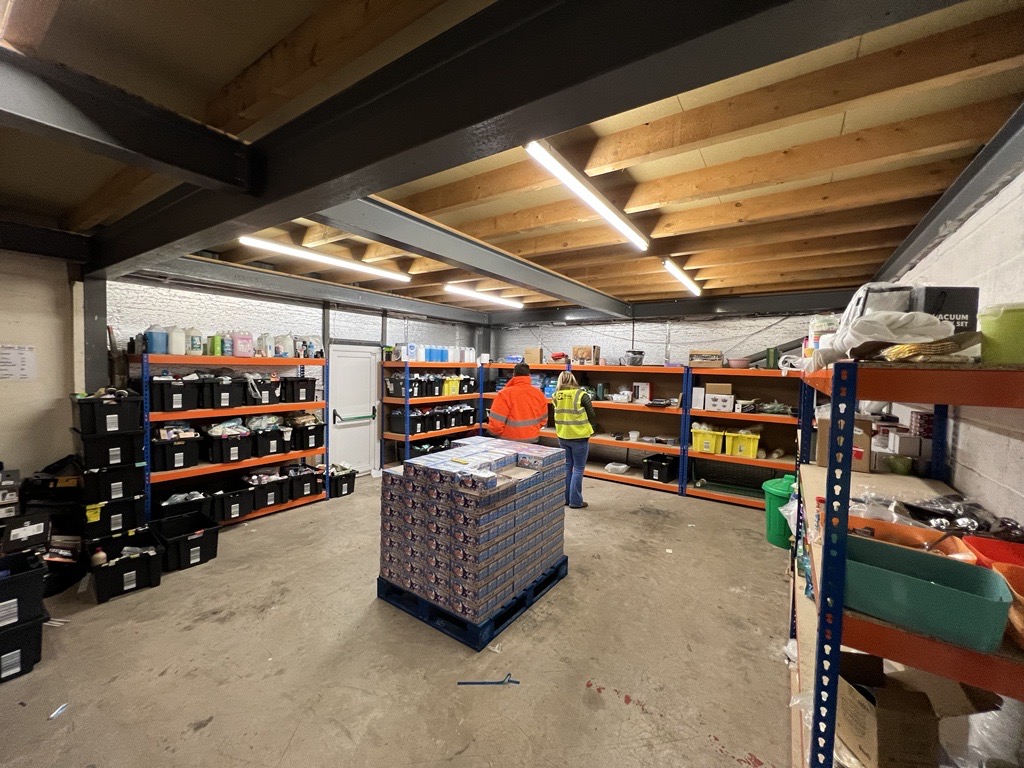Breaking the circle of poverty
Sharon, a single mother living in Kirkcaldy with her three children aged between three and 15, was forced to flee from her ex-partner. To escape his manipulative and coercive behaviour they became homeless. Intimidation, control over her finances, constant monitoring of her daily activity, and isolation from her family and friends all led to her decision to leave. There was no time to pack, so she took her children and left the house she and her ex-partner shared with only the clothes they had on their backs. They essentially had nothing.
These experiences have had a massive impact on Sharon’s children and her own mental well-being. She needed support to heal from the trauma, to help build her confidence to restart her life in unfamiliar surroundings, and a nurturing home environment for her children. The family were moved into an unfurnished property. But starting again, they had very little to create a safe and secure environment.
Shockingly, Sharon’s story is all too common. According to research published by the Centre for Research on Families and Relationships in March 2021, among mothers of young children, 14 per cent reported experiencing domestic abuse in the six years since the birth of their child. With around 320,000 children in Scotland currently aged under seven years old, this means that approximately 45,000 children aged under seven are potentially affected by domestic abuse.
The research also shows that compared to those in the highest income households, mothers on the lowest incomes were far more likely to experience abuse, and they had five times greater odds of experiencing more types of abuse more often, highlighting the impact of poverty.
Poverty statistics released by the Scottish Government measured from 2019 to 2022 show that one in five Scots – more than one million people – live in poverty. Around 250,000 are children and almost half of the total experiencing deprivation are in "very deep" poverty.
Among several goals, the Scottish Government ultimately aims to cut the proportion of children in relative poverty to 10 per cent by 2030-31. But poor pay and inadequate welfare put these goals at risk, according to a report published in October by the Joseph Rowntree Foundation (JRF).
The JRF said that more Scots are facing "extreme hardship" and it is "difficult to see how" Scottish Government poverty targets can be met under current plans. And while it found the Scottish Child Payment – worth £25 per week, per child to eligible low-income families – will likely see child poverty decrease, this "isn't enough" to ensure the targets for 2023-31 are achieved.
Sharon and her family were lucky. After moving to her new property with very little, she was referred to the Cottage Family Centre (CFC), which offers a range of support to families in the Kirkcaldy area, helping families and individuals who are vulnerable to social exclusion as a result of factors such as poverty, unemployment, poor housing, relationship breakdown, drug and alcohol problems, and health-related issues.
Sharon was supported to learn how to be in control of her finances for the first time, and quickly, she learned to manage the little income she had – which she says was barely enough to get by week to week, to pay her utilities, and to buy food. There was nothing left for extras.
Often missing meals to be able to afford to buy her children clothes from local charity shops in her area, the family would also often have to live in an unheated home, which deprived all four of a proper quality of sleep.
All of this took its toll on her. Her eldest would refuse to wear the clothes that were donated as he worried it would make him stand out even more as he started his new school. She felt she was failing as a parent, describing the property as “a bare shell”, carpets from the previous tenant had been removed leaving just the floorboards, and essential white goods were installed when she moved in.
The charity helped her to make a grant application for carpets and white goods from the local authority and apply for support through the Big Hoose Project – the UK’s first multibank. Set up by the CFC after signing an agreement with Amazon UK and other companies in 2022, the Big Hoose Project provides millions of pounds of household goods to children and families living in poverty across Fife. It has been described as a “game-changer”.
I visited the Big Hoose on a bitterly cold early December morning in Lochgelly. Greeted by Grant Barnes, the project’s logistics coordinator, he quickly introduced me to Pauline Buchan, strategic manager and Kelly Rodgers, team manager of the CFC, as a large lorry arrived at the warehouse with tens of pallets packaged with goods.
Buchan shows me around the vast warehouse as Barnes and his colleagues begin to sort the pallets. It has everything a normal foodbank would have, but that’s just the start of it. She shows me clothes, shoes, pet food, bedding, toiletries, kettles, toasters – you name it, they have it.

There is very little room for more goods to be stored once the pallets are offloaded, so I ask her how long all of this will be here for. “Not long, by the end of the week it’ll be away. We’ve worked out that if we didn’t refill this room every 72 hours it would be empty,” she tells me.

There is a clear need for these items in Kirkcaldy. As of 2021, 4,346 kids were living in poverty in the town – which is higher than Fife’s average of 22 per cent. Even more alarming, pockets of the town are seeing truly shocking levels of poverty: more than 75 per cent of children in the Linktown Central area, and more than 50 per cent in Sinclairtown West and Sinclairtown Central.
Buchan, who makes it clear there should be more of a focus on looking at individuals' situations rather than looking at statistics, says: “We are never going to get these people out of the bit unless we can get them to a place where they feel better about themselves and the confidence to go out there and get a job.
“But to be honest, there are so many people that I see that are working, some with more than one job, but they’re not at least breaking even by the end of the month. They earn too much to get any benefit support. In some ways, some of these families are in worse positions than people on benefits.
“At least those people will normally fit a criteria where they can get support from somewhere, some people who sit in that middle bracket don’t meet anyone’s criteria. They are the people that look to payday loan companies, or in some cases, they go and borrow from the street.”
Buchan points out that these spiralling issues that can be caused by taking high-interest loans because of a lack of support, and they then find themselves wrapped in “drugs and crime”, as they are “held to ransom”. And this is not uncommon, she tells me. A quarter of her referrals are involved in some level of this kind of debt.
Throughout the hours I spent with Buchan at the Big Hoose Project, the issue of housing was brought up many times. Buchan and Rodgers are clear that at the policy level, things need to change.
“The re-let standards need to change”, says Buchan. “You get someone into a property, whether it's a council property or through a housing association, and so often families go into that property, and it has nothing in it.
“But the person who left that house, probably, left it in good condition. So, we are talking about carpets, curtain poles, light shades, and all the things that make a house a hame. But what we have found is that often the council or an association will go in and strip all that out and bin it.
“Then along comes the person that is moving into that house, and most of the time they are starting with nothing. Then what happens is the tenant applies for the welfare fund, but it will only provide what it sees as a necessity, which is normally a bed, a washing machine, a cooker, and not a lot else. Then that’s where people come to charities like us.”
There can’t be many people who understand the issue of poverty and the effect it has on a person like Buchan does. Starting at the CFC as a 21-year-old parent with no qualifications, she says she has “gone full circle”, now 48 and in charge of the charity. She continues to tell me about the problems within housing, saying that when she gave up her council property to move into a house she had bought, she left behind more than carpets and curtains. She left working TVs and some furniture for the next tenant. Buchan later came into contact with the woman who moved into her old house. Most of the items she had left were removed and soon after she was met with a removal fee.
Holyrood contacted eight local authorities that have the ten areas with the highest poverty to ask what their policy is on items and housing fabrics left in a re-let property. Some of these council areas, such as Glasgow City Council and Inverclyde Council, no longer have any social housing stock, instead, residents use housing associations.
North Lanarkshire Council remove items such as carpets and white goods which could potentially cause safety concerns and any tenants who leave behind items such as TVs and furniture are charged for the cost of removal. They say their default is to remove white goods, as they would not know what warranty exists, if any, on such goods.
Clackmannanshire Council take a different approach. The prospective tenants can view the property they are to be offered before turnaround works begin, allowing them to discuss what repairs are to be carried out. If items have been left by the previous tenant, the new tenant will advise if they want the items left – including carpets, furniture, and white goods, provided they pass a PAT test. They do not charge previous tenants for the removal of items.
Fife Council, which did not directly address all the questions put to them, said: “Our aim is to make sure there are priority items available in every home including carpets, curtains, white goods, couches, and beds. Items need to be checked for safety, suitability and sustainability.”
It is clear that there is not a standard approach between local authorities and Buchan says that having such an approach that allows items from a previous tenant to be kept “would be the biggest thing we could do for this country in terms of tackling poverty”.
This Christmas, the CFC has its largest Christmas appeal to date. They will deliver presents, a Christmas dinner, as well as 10 days of food to families across Kirkcaldy. And as they get ready to start delivering packages Buchan reminds me that while this time of year is so important to get to people, this is not just a seasonal issue. “Some people don’t even have cookers to cook the dinner they’re given”, she says.
The CFC surveyed families living in poverty in Kirkcaldy after the most recent round of poverty statistics was published, and shockingly, it found that 11 per cent of parents are worried their children would end up in the care system because they are unable to provide for them.
“We are looking at situations where parents have not harmed their children, they just don’t have enough money to look after them. That is the road we are on.”
Holyrood Newsletters
Holyrood provides comprehensive coverage of Scottish politics, offering award-winning reporting and analysis: Subscribe